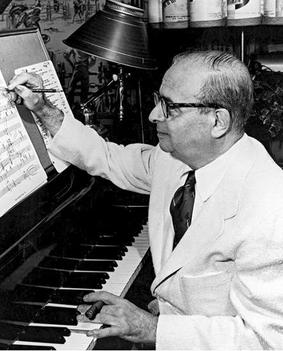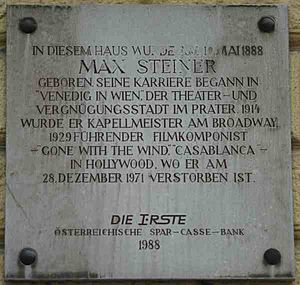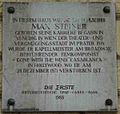Max Steiner facts for kids
Quick facts for kids
Max Steiner
|
|
|---|---|

Steiner composing
|
|
| Born |
Maximilian Raoul Steiner
May 10, 1888 Vienna, Austria-Hungary (now Austria)
|
| Died | December 28, 1971 (aged 83) Los Angeles, California, U.S.
|
| Nationality | American (naturalized citizen 1920) |
| Occupation | Composer, arranger, conductor |
| Years active | 1907–1965 |
| Spouse(s) |
|
Maximilian Raoul Steiner (born May 10, 1888 – died December 28, 1971) was an Austrian composer and conductor. He moved to America and became one of Hollywood's most famous music composers.
Steiner was a child genius. He led his first operetta (a short opera) when he was just twelve years old. By age fifteen, he was a full-time professional, skilled at composing, arranging, and conducting music. During World War I, he had to leave England. He went to Broadway in New York.
In 1929, Steiner moved to Hollywood. He was one of the first composers to write original music for films. People often call him "the father of film music." He helped create the tradition of writing special music for movies. Other important composers like Dimitri Tiomkin and Erich Wolfgang Korngold also helped.
Steiner wrote music for over 300 films. He worked with studios like RKO Pictures and Warner Bros.. He was nominated for 24 Academy Awards (Oscars) and won three. These were for The Informer (1935), Now, Voyager (1942), and Since You Went Away (1944).
Some of his most famous works include King Kong (1933) and Casablanca (1942). He did not write the famous love song "As Time Goes By" for Casablanca. His music for Gone with the Wind (1939) is very well-known. It is ranked as one of the best American film scores ever.
Steiner also won the first Golden Globe Award for Best Original Score. This was for his music in Life with Father. He often worked with famous directors like Michael Curtiz and John Ford. He also scored many films starring actors like Bette Davis and Humphrey Bogart.
Contents
- Max Steiner's Early Life (1888–1907)
- Starting a Music Career (1907–1914)
- Broadway Music Career (1914–1929)
- Composing for RKO Pictures (1929–1937)
- Composing for Warner Bros. (1937–1953)
- Later Works and Legacy (1953–1971)
- How Max Steiner Composed Music
- Max Steiner's Influence and Awards
- Max Steiner's Famous Film Scores
- Images for kids
- See also
Max Steiner's Early Life (1888–1907)
Max Steiner was born on May 10, 1888, in Vienna, Austria-Hungary. He was the only child in a rich family involved in business and theater. His family was Jewish. He was named after his grandfather, Maximilian Steiner, who managed Vienna's famous Theater an der Wien.
Max's father, Gabor Steiner, was a show manager and inventor. He built the Wiener Riesenrad (a giant Ferris wheel). His father encouraged Max's musical talent. Max conducted an American operetta called The Belle of New York at age twelve. This helped him get noticed early on.
Max's godfather was the famous composer Richard Strauss. Strauss greatly influenced Max's future music. Max often said his family inspired his early musical skills. He started piano lessons at six years old. He often got bored and would make up his own music. His father told him to write it down.
Max liked the music of Claude Debussy, which was very new for the time. In his youth, he wrote marches for military bands and hit songs for his father's shows.
Max's parents sent him to the Vienna University of Technology. But he was not interested in school subjects. In 1904, he joined the Imperial Academy of Music. He was so talented that he finished a four-year course in just one year. He won a gold medal from the academy at age fifteen.
He learned to play many instruments. These included piano, organ, violin, and trumpet. The piano was his favorite. He also studied harmony, counterpoint, and composition. His teachers included Gustav Mahler and Felix Weingartner.
Starting a Music Career (1907–1914)
The music of Edmund Eysler influenced Max Steiner's early pieces. Steiner also learned about operettas from Franz Lehár. Lehár worked as a military bandmaster for Steiner's father's theater. In 1907, Steiner created an operetta like Lehár's Die lustige Witwe in Vienna.
Eysler was known for his operettas, but their stories were often simple. The music relied a lot on the Viennese waltz style. Because of this, many of Steiner's later film scores, like Dark Victory (1939), used waltz melodies often.
From 1907 to 1914, Steiner traveled between Britain and Europe. He worked on theater shows. He started his professional music career at fifteen. He wrote and conducted an operetta called The Beautiful Greek Girl. His father thought it wasn't good enough. But a rival show manager produced it, and it ran for a year.
This success led him to conduct other shows in cities like Moscow and Hamburg. When he returned to Vienna, his father was bankrupt. Max struggled to find work. He moved to London, partly to follow a showgirl he had met. In London, he conducted Lehar's The Merry Widow. He stayed in London for eight years, conducting musicals.
Steiner married Beatrice Tilt on September 12, 1912. The exact date of their divorce is not known.
In England, Steiner wrote and conducted theater shows and symphonies. But when World War I began in 1914, he was held as an "enemy alien." Luckily, the Duke of Westminster, who liked his music, helped him get papers to go to America. He arrived in New York City in December 1914 with only $32. He took small jobs, like copying music, which led him to jobs arranging musicals.
Broadway Music Career (1914–1929)
In New York, Max Steiner quickly found work. For fifteen years, he was a musical director, arranger, and conductor for Broadway shows. He worked on operettas and musicals by famous composers like George Gershwin.
In 1915, at age twenty-seven, Steiner became the musical director for Fox Film. At that time, films did not have special music written for them. Steiner suggested writing an original score for the film The Bondman (1916). Fox agreed, and they used a 110-piece orchestra for the screenings.
While working on Broadway, he married Audree van Lieu in 1927. They divorced in 1933. In 1927, Steiner arranged and conducted Rio Rita. The composer, Harry Tierney, later asked RKO Pictures in Hollywood to hire Steiner.
William LeBaron, RKO's head of production, watched Steiner conduct. He was very impressed. Steiner eventually became a valuable part of Hollywood. His last Broadway show was Sons O' Guns in 1929.
Composing for RKO Pictures (1929–1937)
Harry Tierney's request led RKO to hire Max Steiner as an orchestrator. His first film job was writing music for the opening and closing titles. He also wrote music that played "on screen." At first, filmmakers thought film music was a "necessary evil" that slowed things down.
Steiner's first full film score was for Cimarron. The music was well-liked and helped the film's success. He turned down offers to teach film scoring in other countries to stay in Hollywood. In 1932, David O. Selznick, a new producer at RKO, asked Steiner to add music to Symphony of Six Million.
Steiner composed a short piece. Selznick loved it and asked him to write music for the whole film. Before this, music was not used much as background. Steiner was a pioneer in using original music as background scores for films. The successful music in Symphony of Six Million was a turning point for Steiner and for the film industry.
The Impact of King Kong (1933)
The music for King Kong (1933) was Steiner's big breakthrough. It changed how music was used in fantasy and adventure films. The music was very important because it made an unrealistic story feel real. Studio bosses were unsure about needing an original score. But they disliked the special effects, so they let Steiner try to improve the film with music.
The studio suggested using old music to save money. However, King Kong producer Merian C. Cooper asked Steiner to write a new score and offered to pay for the orchestra. Steiner used an eighty-piece orchestra. He said the film "was made for music." He wrote the music in two weeks, and it cost about $50,000.
King Kong became a "landmark of film scoring." It showed how music can control audience emotions. Steiner used a technique called leitmotif, where special musical themes are created for main characters or ideas. For example, the monster's theme is a recognizable three-note tune.
After King Kong dies, his theme and the theme for Fay Wray (the woman) combine. This shows their "Beauty and the Beast" relationship. The music in the end helped show Kong's tender feelings for the woman without words. Cooper said 25 percent of the film's success was due to the music. Steiner later said King Kong was one of his favorite scores.
King Kong quickly made Steiner one of Hollywood's most respected names. He stayed as RKO's music director for two more years. Max married Louise Klos, a harpist, in 1936. They had a son, Ron, and divorced in 1946. Steiner composed music for another 55 films. This included most of Fred Astaire and Ginger Rogers' dance musicals.
RKO producers often asked Steiner for help with films. Director John Ford asked Steiner to score his film, The Lost Patrol (1934), which needed more tension. Ford hired Steiner again for The Informer (1935). In 1937, Frank Capra hired Steiner to conduct Dimitri Tiomkin's music for Lost Horizon. Selznick started his own company in 1936 and hired Steiner for his next three films.
Composing for Warner Bros. (1937–1953)
In April 1937, Steiner left RKO and signed a long contract with Warner Bros.. He still worked for Selznick sometimes. His first film for Warner Bros. was The Charge of the Light Brigade (1936). Steiner became a key composer at Warner Bros. He scored 140 films over the next 30 years. He worked with stars like Bette Davis and Humphrey Bogart.
In 1939, Selznick borrowed Steiner from Warner Bros. to compose the music for Gone with the Wind (1939). This became one of Steiner's biggest successes. Steiner was the only composer Selznick considered for the film. Steiner had only three months to finish the music. He also scored twelve other films that year, more than any other year in his career.
To meet the deadline, Steiner sometimes worked 20 hours straight. When the film came out, it had the longest film score ever, almost three hours long. The music had 16 main themes and nearly 300 musical parts. Steiner had help from four other musicians to work on the score.
Selznick wanted Steiner to use only old classical music to save money and time. But Steiner convinced him that original music would be better for the film's emotions. Steiner ignored Selznick's wishes and wrote a completely new score. The most famous theme is the "Tara" theme for the O'Hara family's home. Steiner said the "Tara" theme starts and ends the film because it shows Scarlett's deep love for her home.
Gone with the Wind won ten Academy Awards. However, it did not win for Best Original Score. That award went to The Wizard of Oz. The score of Gone with the Wind is ranked as the second greatest American film score of all time by AFI.
Now, Voyager earned Steiner his second Academy Award. Steiner used musical themes to show the characters' emotional growth. After Now, Voyager (1942), Steiner scored Casablanca (1942). Steiner usually waited until a film was edited before scoring it. After watching Casablanca, he thought the song "As Time Goes By" was not right for the movie. He wanted to replace it with his own song.
However, the actress Ingrid Bergman had already cut her hair for another film. So, she could not refilm the scene with Steiner's new song. Stuck with "As Time Goes By," Steiner made it the main theme of his score. Steiner's music for Casablanca was nominated for an Oscar but lost to The Song of Bernadette (1943). Steiner won his third and final Oscar in 1944 for Since You Went Away (1944). In 1947, Max married Leonette Blair.
Steiner also did well with film noir movies. The Big Sleep, Mildred Pierce, and The Letter were some of his best film noir scores in the 1940s. In 1947, he scored a film noir Western called Pursued.
Steiner had more success with Western films. He wrote music for over twenty large Westerns. Most had grand, inspiring music about building empires. Examples include Dodge City (1939) and The Oklahoma Kid (1939). In Dodge City, Steiner used a "lifting, loping melody" to show the movement of wagons and horses. The Searchers (1956) is now seen as his greatest Western score.
Later Works and Legacy (1953–1971)
Steiner's contract with Warner Bros. ended in 1953. But he returned in 1958 to score films like Band of Angels and A Summer Place. He also worked on television shows. Steiner still liked using large orchestras and leitmotif techniques. His work slowed down in the mid-1950s, and he started working as a freelancer.
In 1954, RCA Victor asked Steiner to create an orchestral suite of music from Gone with the Wind. This was released on an LP and later on CD. Composer Victor Young and Steiner were good friends. Steiner finished the film score for China Gate after Young died. The film credits say: "Music by Victor Young, extended by his old friend, Max Steiner."
Many of Steiner's film scores are available as soundtrack recordings. Steiner continued to write music into his seventies, even though he was ill and nearly blind. His music still showed new and creative ideas. The theme for A Summer Place in 1959, written when Steiner was 71, became a huge hit. This memorable instrumental theme was #1 on the Billboard Hot 100 singles chart for nine weeks in 1960.
In 1963, Steiner started writing his autobiography (his life story). It was finished but never published. It is the only source of information about Steiner's childhood. A copy is kept at Brigham Young University in Provo, Utah. Steiner scored his last piece in 1965. He said he would have done more films if he had been offered them.
His lack of work later in life was because Hollywood's taste in film music changed. New producers wanted different styles. Also, his failing eyesight and poor health made him retire.
Steiner died of heart failure in Hollywood at age 83. He is buried at Forest Lawn Memorial Park Cemetery in Glendale, California.
How Max Steiner Composed Music
Music as Background for Dialogue
In the early days of sound films, producers avoided playing music during dialogue. They thought audiences would wonder where the music was coming from. So, Steiner noted, "They began to add a little music here and there to support love scenes or silent sequences."
Music was often used in scenes where it made sense, like in a nightclub or ballroom. To add music where it wasn't expected, it was sometimes made part of the scene. For example, a shepherd boy might play a flute, with an orchestra playing in the background.
At first, half the music was recorded on set. This caused problems when scenes were edited, as the music would often be ruined. As recording technology improved, Steiner could record music synced to the film. He could also change the music after the film was edited.
Steiner often followed his own ideas when creating film scores. For example, he went against Selznick's idea to use classical music for Gone with the Wind. He felt that using well-known classical pieces could distract the audience. Steiner was among the first to see the need for original music for each film.
Steiner believed that knowing when to start and stop music was the hardest part. If music is placed incorrectly, it can make a slow scene seem fast, or vice versa. He said, "Knowing the difference is what makes a film composer."
Using Click Tracks
Some people say Steiner invented the click track technique. However, he and Roy Webb were among the first to use it in film scoring. This technique helps composers sync music and film very precisely. It involves punching holes into the soundtrack film based on the speed of a metronome.
As the holes pass through a projector, the orchestra and conductor hear a clicking sound through headphones. This allows them to record the music at the exact timing of the film. This method helped conductors match the music perfectly to the film. It also meant they didn't have to stop or cut music during recording.
This technique allowed Steiner to "catch the action." This means creating sounds for small details on screen. Steiner reportedly spent more time matching the action to the music than composing the melodies. Composing came easily to him.
Using Leitmotifs in Film Music
Steiner's training in European opera and stage music influenced his work in Hollywood. He brought many older techniques that helped develop film scores. He often said that Richard Wagner, who invented the leitmotif, would have been the best film composer if he lived in Steiner's time.
Steiner used leitmotifs a lot in his music. A leitmotif is a short, repeating musical idea linked to a character, place, or idea. He would also use well-known melodies, like national anthems. Steiner was sometimes criticized for using "Mickey Mousing." This technique precisely matches music to actions or gestures on screen. For example, in Of Human Bondage, Steiner created a limping sound with his music whenever the character with a clubfoot walked.
One of Steiner's main rules was: Every character should have a theme. He believed music could tell us everything we need to know about a character. To do this, Steiner linked the music, the story, and the leitmotif. This created a strong structure for his compositions.
A good example of how characters and music worked together is in his score for The Glass Menagerie (1950):
- For Laura, the main character with a physical disability, Steiner used sounds that felt "glassy." He used instruments like the vibraphone and glockenspiel. This showed her escape into a make-believe world of glass figures.
- For Tom, Laura's brother, his theme had a "big-city blues" sound. It was rich and warm, showing his kind nature.
- For Jim, the "gentleman caller," Steiner's clear melody showed his likability and honesty.
Steiner also created themes to add emotion to scenes that originally lacked it:
- King Kong (1933): The music told the story. It showed Kong's "feelings of tenderness" for the woman. The music expressed feelings the camera could not.
- The Letter (1940): The music created a feeling of "tropical tension and violence." It emphasized the film's tragic themes.
- The Big Sleep (1946): The music "darkens to match" the changing mood of the film. It created a closed-in feeling.
- The Treasure of the Sierra Madre (1948): The music made the characters' suffering more intense. It showed the theme of greed.
Mixing Realistic and Background Music
When adding music to a film, Steiner used a "spotting process." He and the director would watch the film and decide where music should start and stop. Steiner also mixed realistic music (music that characters in the film would hear) with background music. For example, a character humming a tune might be joined by an orchestra playing that tune.
Steiner was sometimes criticized for this technique because it could make viewers too aware of the music. However, Steiner understood that the music should support the film, not take over. He said, "if it gets too decorative, it loses its emotional appeal."
Before 1932, filmmakers tried to avoid background music. Steiner was known for writing atmospheric music without strong melodies for neutral scenes. This allowed the music to blend in without distracting from the film. Sometimes, Steiner used music that was part of the story to emphasize or even contradict emotions. He believed there was "no greater counterpoint ... than gay music underlying a tragic scene or vice versa."
Max Steiner's Influence and Awards
Awards and Recognition
Max Steiner won three Academy Awards (Oscars) for his music: The Informer (1935), Now, Voyager (1942), and Since You Went Away (1944). He received a certificate for The Informer. For the other two, he first received plaques, which were later replaced with Oscar statuettes in 1946.
Steiner was nominated for 20 individual Academy Awards. Before 1939, the Academy recognized a studio's music department, not individual composers. So, even though his music for The Informer won, the Academy does not officially count Steiner as the individual winner for that one. His 20 nominations make him the third most nominated person in film scoring history.
The United States Postal Service honored Steiner with a stamp in 1999. After his death, conductor Charles Gerhardt led an orchestra in an album of Steiner's music highlights called Now Voyager. Steiner also won a Golden Globe for Best Original Score for Life with Father (1947).
In 1975, Steiner received a star on the Hollywood Walk of Fame for his work in motion pictures. In 1995, he was added to the Songwriters Hall of Fame. In 1988, a memorial plaque was placed at his birthplace in Vienna. In 1990, Steiner was one of the first to be recognized for Lifetime Achievement by an online awards site.
His Legacy Among Other Composers
Kurt London, in his book Film Music, said that American film music was not as original as European film music. But he said Steiner's music was an exception. Steiner, along with Erich Wolfgang Korngold and Alfred Newman, helped define the style of film music for their time and for the future.
James Bond composer John Barry said Steiner influenced his work. James Newton Howard, who scored the 2005 remake of King Kong, was influenced by Steiner's original score. In the 2005 film, during the tribal sacrifice scene, the music is actually from Steiner's 1933 score.
Star Wars composer John Williams also said Steiner and other European composers from the "Golden Age" of film music influenced his work. George Lucas wanted Williams to use Steiner's and Korngold's music as inspiration for Star Wars.
Steiner was often compared to his friend and rival at Warner Bros., Erich Wolfgang Korngold. Some critics thought Korngold's music was better. However, according to William Darby and Jack Du Bois's American Film Music, no other composer created as many "very good" scores as Steiner.
Steiner was one of the first composers to bring music back into films after talking films were invented. His score for King Kong showed how to add background music to a movie. Some of his peers did not like his "Mickey Mousing" technique. But they agreed he had a successful career and a good "melodic sense."
Now, people call Steiner the "father of film music." By the end of his career, he had written or arranged music for over three hundred films. The Max Steiner Music Society was formed to honor him, publishing journals and keeping a library of his recordings.
Max Steiner's Famous Film Scores
The American Film Institute ranked Steiner's music for Gone with the Wind (1939) as #2 and King Kong (1933) as #13 on their list of the 25 greatest film scores.
His music for these films was also nominated for the list:
- The Informer (1935)
- Jezebel (1938)
- Dark Victory (1939)
- Casablanca (1942)
- Now, Voyager (1942)
- Adventures of Don Juan (1948)
- Johnny Belinda (1948)
- The Treasure of the Sierra Madre (1948)
- A Summer Place (1959)
Images for kids
See also
 In Spanish: Max Steiner para niños
In Spanish: Max Steiner para niños






